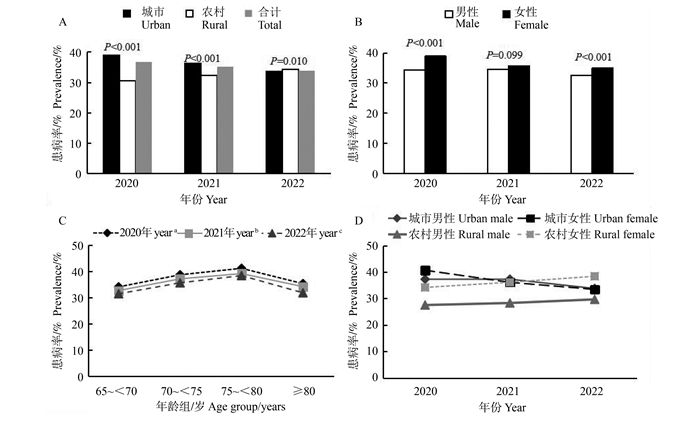Trends in the prevalence of metabolic syndrome among the ≥65 years elderly from 2020 to 2022 in Qixia District of Nanjing
-
摘要:
目的 了解南京市栖霞区≥65岁老年人代谢综合征(metabolic syndrome, MS)患病率的变化趋势及其相关影响因素,为采取针对性的干预措施提供参考依据。 方法 采用分层随机抽样,选择2020―2022年在南京市栖霞区参与体检的≥65岁人群为研究对象,分析其MS患病率变化趋势及相关影响因素。 结果 2020―2022年南京市栖霞区≥65岁人群的MS总患病率分别为36.72%、35.17%、33.80%,标化患病率分别为36.60%、35.11%、33.67%,呈下降趋势(趋势χ2 =41.021, P < 0.001);城乡分层后,城市≥65岁人群MS患病率呈下降趋势(趋势χ2 =95.499, P < 0.001);农村≥65岁人群MS患病率呈上升趋势(趋势χ2 =16.237, P < 0.001)。 结论 南京市栖霞区≥65岁人群MS总患病率2020―2022年虽然呈下降趋势,但依然较高,尤其是农村地区MS患病率呈上升趋势,农村地区女性MS患病率增幅快,应重点关注。 Abstract:Objective To investigate the trend of metabolic syndrome (MS) prevalence and related factors in elderly people aged ≥65 in Qixia District of Nanjing, and provide reference for targeted intervention measures. Methods Employing a method which the sampling technique was stratified and randomized, A stratified random sampling method was adopted. Elderly individuals aged ≥65 in the Qixia District of Nanjing who underwent health check-ups between 2020 and 2022 were selected as subjects. The trend in the prevalence of MS and the associated factors were analyzed. Results The overall prevalence rates of MS among the elderly in Qixia District of Nanjing were as follows: 36.72% in 2020, 35.17% in 2021, and 33.80% in 2022. The standardized prevalence rates were 36.60%, 35.11%, 33.67%, respectively. These rates indicated a decreasing trend (trend χ2 =41.021, P < 0.001). When the data which was stratified by urban-rural differences, the prevalence of MS among urban elderly displayed a downward trend (trend χ2 =95.499, P < 0.001). The prevalence of MS among rural elderly displayed an upward trend (trend χ2 =16.237, P < 0.001). Conclusions Although the overall prevalence of MS in the elderly in Qixia District of Nanjing decreases from 2020 to 2022, it is still high. Especially in rural areas, the prevalence of MS shows an upward trend, particularly among rural females who urgent need for intervention. -
Key words:
- Metabolic syndrome /
- Elderly /
- Prevalence rate /
- Trends
-
图 1 南京市栖霞区2020―2022年不同特征≥65岁老年人MS患病率变化趋势
MS:代谢综合征; A中P值表示城乡患病率比较;C中a、b、c表示不同年份各年龄组MS患病率差异,P < 0.05。
Figure 1. Trends in the prevalence of MS among the elderly ≥65 years from 2020 to 2022 in Qixia District of Nanjing
MS: metabolic syndrome; In the figure A P value represents the comparison of urban and rural prevalence rates; In the figure C, a, b, and c indicate the difference of MS prevalence in different age groups in different years, P < 0.05.
表 1 南京市栖霞区2020―2022年≥65岁老年人群基本特征
Table 1. Characteristics of the elderly ≥65 years and above in Qixia District of Nanjing from2020 to 2022
特征Characteristic 2020年year ①(n=15 045) 2021年year ①(n=19 638) 2022年year ①(n=28 712) 合计 ① Total ①(n=63 395) χ2值value P值value 居住地Residence 4.600 0.100 城市Urban 10 685(71.02) 13 778(70.16) 20 120(70.08) 44 583(70.33) 4.600 0.100 农村Rural 4 360(28.98) 5 860(29.84) 8 592(29.92) 18 812(29.67) 性别Gender 0.873 0.646 男性Male 7 060(46.93) 9 312(47.42) 13 520(47.09) 29 892(47.15) 女性Female 7 980(53.04) 10 326(52.58) 15 192(52.91) 33 503(52.85) 年龄组/岁Age group /years 164.000 ② < 0.001 65~ < 70 6 163(40.96) 8 195(41.73) 10 908(37.99) 25 266(39.85) 70~ < 75 4 604(30.60) 5 800(29.53) 8 269(28.80) 18 673(29.46) 75~ < 80 2 462(16.36) 3 235(16.47) 4 786(16.67) 10 483(16.54) ≥80 1 816(12.07) 2 408(12.26) 4 749(16.54) 8 973(14.15) 锻炼情况Exercise 842.936 < 0.001 是Yes 4 163(27.67) 7 857(40.01) 11 842(41.24) 23 862(37.64) 否No 10 882(72.33) 11 781(59.99) 16 870(35.94) 39 533(62.36) 膳食习惯Dietary habit 36.929 < 0.001 平衡Balanced 13 744(91.35) 18 093(92.13) 26 688(92.95) 58 525(92.32) 不平衡No balanced 1 301(8.65) 1 545(7.87) 2 024(7.05) 4 870(7.68) 吸烟Smoking states 32.521 < 0.001 是Yes 2 315(15.39) 3 113(15.84) 3 899(13.58) 9 324(14.71) 否No 12 370(84.61) 16 528(84.16) 18 206(86.42) 54 071(85.29) 饮酒Alcohol 64.640 < 0.001 是Yes 2 013(13.38) 2 579(13.13) 3 199(11.14) 7 791(12.29) 否No 13 032(86.62) 17 059(86.87) 25 513(88.86) 55 604(87.71) 注:①以人数(占比%)表示;②采用秩和检验。
Note: ① Number of people(proportion%);② Rank-sum test.表 2 南京市栖霞区2020―2022年不同特征≥65岁老年人MS患病率
Table 2. The prevalence of MS in different characteristics of the elderly ≥65 years in Qixia District of Nanjing from 2020 to 2022
变量Variable 2020年year ① 2021年year ① 2022年year ① 趋势χ2值Trend χ2 value P值value 总患病率Total prevalence rate 5 525(36.72) 6 907(35.17) 9 704(33.80) 37.986 < 0.001 标化患病率Standardized prevalence rate 5 506(36.60) 6 895(35.11) 9 667(33.67) 41.021 < 0.001 性别Gender 男性Male 2 420(34.28) 3 220(34.58) 4 400(32.54) 12.207 0.002 女性Female 3 105(38.91) 3 687(35.71) 5 304(34.91) 36.826 < 0.001 居住地Residence 城市Urban 4 179(39.11) 5 010(36.36) 6 759(33.59) 95.499 < 0.001 农村Rural 1 346(30.87) 1 897(32.37) 2 945(34.28) 16.237 < 0.001 城市Urban 男性Male 1 823(37.27) 2 424(37.30) 3 198(33.78) 18.141 < 0.001 女性Female 2 356(40.66) 2 586(35.53) 3 561(33.43) 99.769 < 0.001 农村Rural 男性Male 597(27.52) 796(28.30) 1 202(29.66) 3.525 0.172 女性Female 749(34.19) 1 101(36.13) 1 743(38.39) 11.965 0.003 年龄组/岁Age group /years 65~ < 70 2 096(34.01) 2 672(32.61) 3 423(31.38) 12.613 0.002 70~ < 75 1 778(38.62) 2 150(37.07) 2 940(35.55) 12.243 0.002 75~ < 80 1 011(41.06) 1 264(39.07) 1 833(38.30) 5.241 0.073 ≥80 640(35.24) 821(34.09) 1 508(31.75) 8.726 0.013 锻炼情况Exercise situation 是Yes 1 297(31.16) 2 474(31.49) 3 641(30.75) 0.587 0.444 否No 4 228(38.85) 4 433(37.63) 6 063(35.94) 24.894 < 0.001 膳食习惯Dietary habit 平衡Balanced 5 034(36.63) 6 322(34.94) 8 962(33.58) 37.589 < 0.001 不平衡No balanced 491(37.74) 585(37.86) 742(36.67) 0.474 0.491 吸烟Smoking states 是Yes 785(33.91) 1 148(36.91) 1 498(38.42) 12.246 < 0.001 否No 4 740(37.23) 5 759(34.84) 8 206(33.07) 64.649 < 0.001 饮酒Alcohol 是Yes 775(38.52) 984(38.15) 1 240(38.76) 0.060 0.806 否No 4 750(36.45) 5 923(34.72) 8 464(33.18) 41.916 < 0.001 注:MS, 代谢综合征; 标化率采用第七次人口普查年龄构成计算。
①以人数(占比%)表示。
Note: MS, metabolic syndrome; The standardized rate was calculated using the age composition of the Seventh National Population Census.
①Number of people(proportion%).表 3 南京市栖霞区2020―2022年≥65岁老年人MS各组分患病率
Table 3. The prevalence rate of MS components in different characteristics of the elderly ≥65 years in Qixia District of Nanjing from 2020 to 2022
MS各组分MS component 2020年year 2021年year 2022年year P值value③ 城市
Urban农村
Rural合计
Total城市
Urban农村
Rural合计
Total城市
Urban农村
Rural合计
Total血压升高Hypertensive 79.82 85.32 81.42 82.60 ① 84.98 83.31 ① 80.53 ② 80.05 ② 80.38 ② < 0.001 中心性肥胖Central obesity 50.00 40.85 47.34 46.21 ② 47.26 ① 46.89 43.51 ② 48.50 ① 44.64 ② < 0.001 血糖升高Hyperglycemia 44.94 33.10 41.24 44.57 35.19 ① 42.03 40.84 ② 38.90 ① 40.26 ② < 0.001 高TG High TG 33.06 26.77 31.23 28.83 ② 23.72 ② 27.20 ② 28.68 28.79 ① 28.82 ① < 0.001 低HDL-C Low HDL-C 11.17 12.73 11.62 10.22 ② 10.82 ② 10.40 ② 10.63 10.50 10.59 < 0.001 注:MS,代谢综合征; TG, 三酰甘油; HDL-C, 高密度脂蛋白胆固醇。
①患病率与前1年相比上升,P < 0.05; ②患病率与前1年相比下降,P < 0.05;③为2020―2022年总患病率变化趋势χ2检验。
Note: MS, metabolic syndrome; TG, triglyceride; HDL-C, high-density lipoprotein cholesterol.
① The prevalence rate higher than that of the previous year, P < 0.05; ② The prevalence rate lower than that of the previous year, P < 0.05; ③ The P value is a Chi-square test of the trend of total prevalence from 2020 to 2022.表 4 南京市栖霞区2020―2022年≥65岁老年人MS组分异常数量分布
Table 4. Abnormal quantity distribution of MS components in the elderly ≥65 years in Qixia District of Nanjing from 2020 to 2022
MS异常组分数量
The number of abnormal components of MS2020年year 2021年year 2022年year 趋势χ2值Trend χ2 value P值value 5 2.10 2.11 1.97 1.116 0.291 4 10.63 9.74 9.56 11.543 < 0.001 3 23.99 23.33 22.28 17.681 < 0.001 2 32.66 32.49 31.71 4.778 0.029 1 24.11 25.39 26.38 26.953 < 0.001 0 6.51 6.95 8.11 44.342 < 0.001 注:MS,代谢综合征。
Note: MS, metabolic syndrome. -
[1] 中华医学会糖尿病分会. 中国2型糖尿病防治指南(2017年版)[J]. 中国实用内科杂志, 2018, 38(4): 292-344. DOI: 10.19538/j.nk2018040108.Chinese Diabetes Society. Guidelines for the prevention and treatment of type 2 diabetes in China (2017 edition)[J]. Chin J Pract Intern Med, 2018, 38(4): 292-344. DOI: 10.19538/j.nk2018040108. [2] Mottillo S, Filion KB, Genest J, et al. The metabolic syndrome and cardiovascular risk[J]. J Am Coll Cardiol, 2010, 56(14): 1113-1132. DOI: 10.1016/j.jacc.2010.05.034. [3] 黄娟, 孙婷. 老年人代谢综合征及其各组分与糖尿病发病风险间的关系[J]. 中国老年学杂志, 2019, 39(24): 5948-5950. DOI: 10.3969/j.issn.1005-9202.2019.24.014.Huang J, Sun T. Relationship between metabolic syndrome and its components in the elderly and the risk of diabetes mellitus[J]. Chinese Journal of Gerontology, 2019, 39(24): 5948-5950. DOI: 10.3969/j.issn.1005-9202.2019.24.014. [4] Li R, Li WC, Lun ZJ, et al. Prevalence of metabolic syndrome in Mainland China: a meta-analysis of published studies[J]. BMC Public Health, 2016, 16: 296. DOI: 10.1186/s12889-016-2870-y. [5] 中国营养学会. 中国居民膳食指南(2016)[M]. 北京: 人民卫生出版社, 2016: 107.Chinese Nutrition Society. Dietary Guidelines for Chinese residents(2016)[M]. Beijing: People's Medical Publishing House, 2016: 107. [6] 蔡瑞雪, 巢健茜, 孔令燕, 等. 四种代谢综合征诊断标准在老年人中的适用性比较[J]. 中华疾病控制杂志, 2019, 23(2): 146-149, 161. DOI: 10.16462/j.cnki.zhjbkz.2019.02.005.Cai RX, Chao JQ, Kong LY, et al. Comparison of four different metabolic syndrome diagnostic criteria among the elderly in Nanjing[J]. Chin J Dis Control Prev, 2019, 23(2): 146-149, 161. DOI: 10.16462/j.cnki.zhjbkz.2019.02.005. [7] 李望. 成都市中老年人代谢综合征患病情况及其危险因素分析[J]. 中国公共卫生, 2021, 37(1): 40-43. DOI: 10.11847/zgggws1123909.Li W. Prevalence and risk factors of metabolic syndrome among middle-aged and elderly people in Chengdu City[J]. Chin J Public Health, 2021, 37(1): 40-43. DOI: 10.11847/zgggws1123909. [8] 高瑜璋, 乔莹, 胡觉, 等. 苏州市姑苏区65岁以上老年人群代谢综合征流行情况调查分析[J]. 实用糖尿病杂志, 2020, 16(3): 79-80.Gao YZ, Qiao Y, Hu J, et al. Investigation and analysis on the prevalence of metabolic syndrome in the elderly population over 65 years old among Gusu district, Suzhou City[J]. Journal of Practical Diabetology, 2020, 16(3): 79-80. [9] 朱延清, 吴春燕, 吴文君. 昆山市2013―2018年老年人群代谢综合征患病率及流行趋势[J]. 现代医药卫生, 2021, 37(3): 385-387. DOI: 10.3969/j.issn.1009-5519.2021.03.007.Zhu YQ, Wu CY, Wu WJ. Prevalence and epidemic trend of metabolic syndrome in the elderly from 2013 to 2018 in Kunshan City[J]. Journal of Modern Medicine Health, 2021, 37(3): 385-387. DOI: 10.3969/j.issn.1009-5519.2021.03.007. [10] Li WZ, Song FJ, Wang XJ, et al. Prevalence of metabolic syndrome among middle-aged and elderly adults in China: current status and temporal trends[J]. Ann Med, 2018, 50(4): 345-353. DOI: 10.1080/07853890.2018.1464202. [11] Kwon JY, Song SW. Changes in the prevalence of metabolic syndrome in Korean adults after the COVID-19 outbreak[J]. Epidemiol Health, 2022, 44: e2022101. DOI: 10.4178/epih.e2022101. [12] 朱明胜, 陈莲芬. 2012―2017年三亚市健康管理老年人超重和肥胖流行趋势分析[J]. 中国慢性病预防与控制, 2019, 27(9): 676-679. DOI: 10.16386/j.cjpccd.issn.1004-6194.2019.09.009.Zhu MS, Chen LF. Analysis on the epidemic trend of overweight and obesity among the elderly people in Sanya City from 2012 to 2017[J]. Chin J Prev Contr Chronic Dis, 2019, 27(9): 676-679. DOI: 10.16386/j.cjpccd.issn.1004-6194.2019.09.009. [13] 韩琳, 曹冰, 王欣, 等. 中国中老年人高血压与中心性肥胖对糖尿病患病的交互作用[J]. 中国慢性病预防与控制, 2023, 31(3): 165-169. DOI: 10.16386/j.cjpccd.issn.1004-6194.2023.03.002.Han L, Cao B, Wang X, et al. Interactive effects of hypertension and central obesity on the prevalence of diabetes among middle-aged and elderly in China[J]. Chin J Prev Contr Chronic Dis, 2023, 31(3): 165-169. DOI: 10.16386/j.cjpccd.issn.1004-6194.2023.03.002. -





 下载:
下载:

